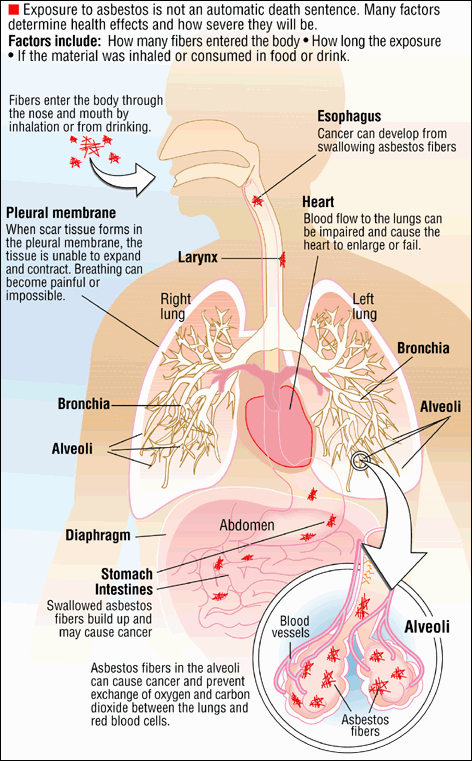
Asbestosis
 Asbestosis is a chronic inflammatory and fibrotic medical condition affecting the parenchymal tissue of the lungs caused by the inhalation and retention of asbestos fibers. It usually occurs after high intensity and/or long-term exposure to asbestos (particularly in those individuals working on the production or end-use of products containing asbestos) and is therefore regarded as an occupational lung disease. People with extensive occupational exposure to the mining, manufacturing, handling or removal of asbestos are at risk of developing asbestosis. Sufferers may experience severe dyspnea (shortness of breath) and are at an increased risk for certain malignancies, including lung cancer and mesothelioma. Asbestosis specifically refers to interstitial (parenchymal) fibrosis from asbestos, and not pleural fibrosis or plaquing.
Asbestosis is a chronic inflammatory and fibrotic medical condition affecting the parenchymal tissue of the lungs caused by the inhalation and retention of asbestos fibers. It usually occurs after high intensity and/or long-term exposure to asbestos (particularly in those individuals working on the production or end-use of products containing asbestos) and is therefore regarded as an occupational lung disease. People with extensive occupational exposure to the mining, manufacturing, handling or removal of asbestos are at risk of developing asbestosis. Sufferers may experience severe dyspnea (shortness of breath) and are at an increased risk for certain malignancies, including lung cancer and mesothelioma. Asbestosis specifically refers to interstitial (parenchymal) fibrosis from asbestos, and not pleural fibrosis or plaquing.
The signs and symptoms of asbestosis do not manifest until after an appreciable latency (time since first exposure), often several decades under current conditions in the US. The primary symptom of asbestosis is generally the slow onset of dyspnea, especially on exertion. Clinically advanced cases of asbestosis may lead to respiratory failure. On auscultation of the lungs, the physician may hear inspiratory rales.
The characteristic pulmonary function finding in asbestosis is a restrictive ventilatory defect. This manifests as a reduction in lung volumes, particularly the Vital Capacity (VC) and Total Lung Capacity (TLC). The TLC may be reduced through alveolar wall thickening; however this is not always the case. Large airway function, as reflected by FEV1/FVC, is generally well preserved. In the more severe cases, the drastic reduction in lung function due to the stiffening of the lungs and reduced TLC may induce right-sided heart failure (cor pulmonale). In addition to a restrictive defect, asbestosis may produce reduction in Diffusion Capacity and arterial hypoxemia.
Asbestosis is the scarring of lung tissue (around terminal bronchioles and alveolar ducts) resulting from the inhalation of asbestos fibers. There are two types of fibers: amphibole (thin and straight) and serpentine (curved). The former are primarily responsible for human disease as they are able to penetrate deeply into the lungs. When such fibers reach the alveoli (air sacs) in the lung, where oxygen is transferred into the blood, the foreign bodies (asbestos fibers) cause the activation of the lung’s local immune system and provoke an inflammatory reaction. This inflammatory reaction can be described as chronic rather than acute, with a slow ongoing progression of the immune system in an attempt to eliminate the foreign fibers. Macrophages phagocytose (ingest) the fibers and stimulate fibroblasts to deposit connective tissue. Due to the asbestos fibers’ natural resistance to digestion, the macrophage dies off, releasing cytokines and attracting further lung macrophages and fibrolastic cells to lay down fibrous tissue, which eventually forms a fibrous mass. The result is interstitial fibrosis. The fibrotic scar tissue causes alveolar walls to thicken, which reduces elasticity and gas diffusion, reducing oxygen transfer to the blood as well as the removal of carbon dioxide.
Mesothelioma
Mesothelioma is a fatal form of cancer that develops in the mesothelium, the protective sac that surrounds the body’s internal organs, such as the lungs, heart, stomach and reproductive organs. The mesothelium is made up of two layers of cells; one layer immediately covers the organ and the other forms the sac around it.
The mesothelium produces a lubricating fluid between the layers allowing movement of the organs so that they can move easily within the body, such as the inflating and deflating lungs, or beating heart against surrounding structures.
The vast majority of people develop mesothelioma as a result of exposure to asbestos fibres. The fibres lodge in a patient’s body either through inhalation or swallowing, affecting the lungs, stomach and/or reproductive organs. Exposure to asbestos often occurs 20 to 40 years prior to the mesothelioma diagnosis.
There are several different types of mesothelioma, including:
– mesothelioma of the pleura, which affects a patient’s lungs and is the most common form of mesothelioma;
– mesothelioma of the peritoneum, which affects a patient’s abdomen;
– mesothelioma of the pericardium, which affects a patient’s heart and is an extremely rare form of mesothelioma; and
– mesothelioma of the tunica vaginalis testis (men) or the tunica serosa uteri (women), which affects a patient’s reproductive organs and is also an extremely rare form of mesothelioma.
